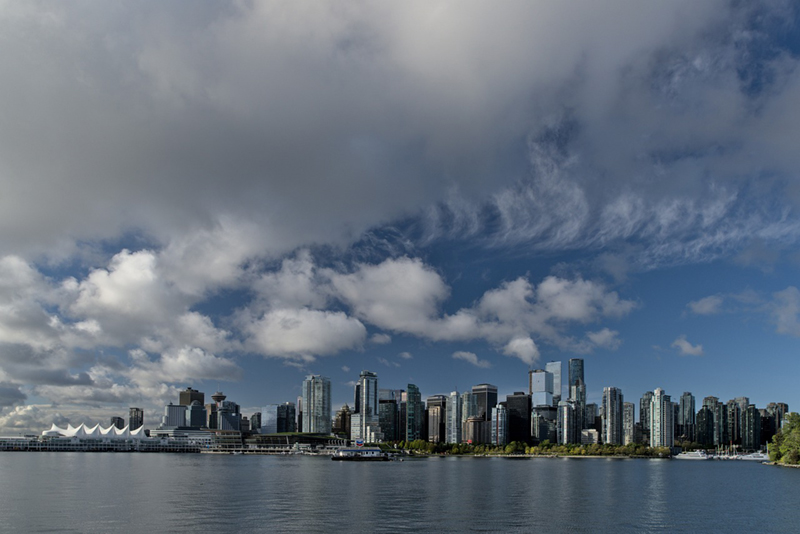Vancouver is an excellent place for growing trees around your home, but it has challenges. One such trial that trees often have to endure is the landfall of atmospheric rivers, which bring heavy rainfall, floods, and mudslides. You should prioritize your safety during these weather anomalies, but it’s also a good idea to prepare your trees before atmospheric river events.
Good tree maintenance and preparation lessen the risk of trees damaging your property and help reduce the impact of looming disasters.
Here’s a guide to Vancouver’s atmospheric rivers and how to protect your trees.

What is an Atmospheric River?
An atmospheric river is a river-like moisture and wind concentration in the sky. It’s part of a low-pressure system carrying water vapour outside the tropics and towards the poles.
This moisture transport is nature’s most significant mechanism for bringing fresh water to other parts of the world.
According to the U.S. Geological Survey, 90 percent of moisture transport worldwide is concentrated into four or five atmospheric rivers at any given time.
It benefits many regions worldwide, often falling on North America’s West Coast, including California in the United States and B.C.’s south coast here in Canada.
However, it also brings strong winds and flood risks to these areas.
Atmospheric rivers flow just about a mile from the ground, but as they reach coasts and mountains, they are pushed upward, which causes them to turn into significant rainfall events, wind storms, or heavy snowfall.
On average, atmospheric rivers can match the flow of water at the mouth of the Mississippi River, but they can also carry up to fifteen times that amount.
In Vancouver, there’s a series of atmospheric rivers hitting the Lower Mainland about twenty to thirty times a year.
They’re usually to be expected in the fall and winter, but the intensity of their landfall is hard to predict, especially with climate change as a factor.
Accurate weather forecasts about extreme precipitation from an atmospheric river usually become available only when it’s already on the city’s doorstep.
How Atmospheric Rivers Impact Vancouver
Atmospheric rivers can replenish Vancouver’s water needs, yet you should also be aware of their adverse effects.
Imagine a literal river hanging above the sky, and then it falls. This heavy precipitation will undoubtedly have an impact.
Once a powerful atmospheric river hits Vancouver, significant rainfall and strong winds can ripple into multiple problems.
These B.C. storms pour hundreds of millimetres of rain— overwhelming the storm drain systems and causing widespread flooding.
When violent winds and severe flooding combine, your home and property become vulnerable to storm damage, and your safety could be at risk.
Other serious concerns include potential landslides, mudslides, and avalanches.
Public infrastructure can also be affected. Damaged powerlines can cause power outages, while floods can result in road washouts.
Your trees can sustain damage, lose branches, or get uprooted entirely.
How Trees Protect Us from Atmospheric Rivers
Trees are important allies in the face of natural disasters in Vancouver.
They offer different ways of preventing or reducing the intensity of floods from atmospheric rivers’ landfalls.
Trees help delay rain’s contact with the ground, lowering the risk of flash floods.
Aside from helping absorb the water, the tree roots also create pathways underground that the rainwater can follow.
In contrast, rainfall in a treeless area will be carried on the surface, more easily causing floods and washouts.
Well-established tree roots can also secure the soil, preventing erosion that leads to landslides and mudslides.
A sturdy tree canopy can help shield your home from the strong winds that often come with rainfall from atmospheric rivers.
Hot Tip! How To Be Prepared For Atmospheric Rivers
Download and use the WeatherCAN app on your mobile device for the latest forecast information directly from Canada’s official weather source.
Be prepared for Winter storms.
Ask your local Arborist to check Hazard Trees. These can cause power outages, and damage to property or people.
Learn what you can about Atmospheric Rivers.
How to Protect Trees from Atmospheric Rivers
While trees can help prevent the worst-case scenarios from happening during a strong atmospheric river’s landfall, trees also need support to withstand it.
As a tree owner, you can take preventive measures to keep your trees safe and stable.
Tree Risk Assessments
You may look at your tree and think it’s healthy and sturdy, but a professional evaluation might tell a different story.
To know your tree’s condition, you can contact your local tree service provider for a tree risk assessment.
An arborist certified by the International Society of Arboriculture will inspect your tree’s health, structural integrity, and surroundings.
They will also suggest solutions to address any issues found during the assessment.
It’s the first step to preventing potential damage a compromised tree might bring when the atmospheric river rains arrive.
Proper Tree Maintenance
Unlike trees in the forest, Vancouver’s urban spaces need more support from their owners to keep them thriving.
This means giving them the regular maintenance services they need to keep them in great shape, such as:
- Tree pruning.
- Deep-root fertilization.
- Pest control.
- Mulching.
It’s better if your local experts do this work. Otherwise, you might compromise your tree’s structure.
Investing in professional services for your trees can save you a lot of trouble and money in the long run.
After all, a neglected tree becomes a liability, especially when it becomes vulnerable to intense weather conditions.
Hazard Tree Removal
If a tree is beyond saving, it’s best to get it removed.
You don’t want a weak or dead tree waiting to fall on your property. Your hazardous trees should go.
In Vancouver, tree removal must be done safely, professionally, and legally. Bylaws require tree experts to confirm that no way to save the tree can be found before a tree removal permit is issued.
The local government may also require a replacement tree to be planted.
Emergency Tree Services
Because of the atmospheric rivers’ often unpredictable intensity, even the strongest and sturdiest trees can be subject to serious damage.
After the rainfalls and floods have subsided, you may find that your tree has become a safety risk. Some telltale signs include:
- Visible signs of damage.
- Broken branches that may fall anytime.
- Exposed roots loosen the tree’s grip on the soil.
- A tree that leans excessively.
- The tree has fallen due to trunk damage or uprooting.
In these scenarios, call your local tree service company right away for emergency tree service.
Depending on the situation, they may prune dangerous branches, make restabilization efforts, or, if necessary, remove trees.
Your Safety Comes First
Atmospheric rivers are nature’s way of keeping the freshwater distribution balanced globally.
Yet this doesn’t change the fact that these rivers of moisture in the sky can be destructive once they fall.
Fortunately, Vancouver is also abundant in trees that help lessen the impact of atmospheric rivers on local communities.
This is why keeping the trees on your property healthy and robust is essential. This gives them the best fighting chance against the atmospheric rivers’ downpours.
Remember that you prioritize your safety whenever these rainfall events loom over Vancouver.
Tune in to your local weather network or follow social media channels to stay informed about the latest flood watches, rainfall warnings, and other advisories.
